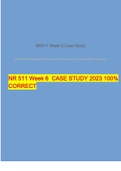Summary
Cross Cultural Marketing Lectures Summary
- Course
- Institution
This document contains a summary of all the lectures provided by the VU for the course Cross Cultural Marketing (E_IBA1_CCM). The important concepts are shown in (colored) bold. The document also shows illustrations and pictures of important concepts, to paint a clearer picture. Goodluck with stu...
[Show more]












